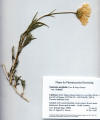|
Xylorhiza glabriuscula |
Xylorhiza tortifolia
|
|
Xylorhiza tortifolia |
|
|
Xylorhiza tortifolia |
Xylorhiza tortifolia
|
|
Trees and Shrubs of Kern County (Sep 2012) Xylorhiza tortifolia (Aplopappus tortifolia Torrey & A. Gray 1845) Greene 1896 [Machaeranthera tortifolia Cronquist & Keck 1957] var. tortifolia. Desert aster. Subshrub with a low widely branched woody base and erect leafless flowering stems; leaves mainly on seasonal relatively short herbaceous branches at the base of the longer flower scapes, alternate, strap-like and twisted, the margins wavy with triangular to spine-like teeth, or teeth lacking, 27 cm long, 318 mm wide, with plain and glandular tipped hairs; flowering MarOct; flowers with 414 lavender or pale purplish rays and many yellow disc florets, the heads solitary and terminal on long leafless flower stems 1018 cm long; involucral bracts numerous in 45 graduated series, sword-shaped; cypselae with a 4-nerved cylindrical pericarpium and terminal silky bristles. Rocky slopes in creosote, shadscale, and sagebrush deserts below 6,500 ft, California to Utah and Arizona. Type from California. Kern Co.: Mostly desert regions, canyons from Owens Peak to Harper Lake, Kramer Junction, Rosamond, Piute Mt., Red Rock and Jawbone, 7312,028 m (CCH). One other variety: var. imberbis (Cronquist) T.J.. Watson, occurs in southern Nevada, Utah and Arizona; it differs in having less hairs. |
|




